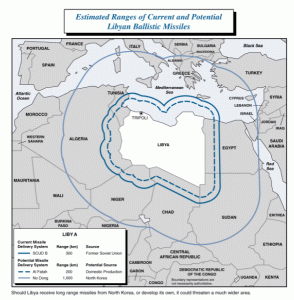Libia è un pericolo per l’Italia: documento esclusivo
Questa foto si riferisce alla gittata dell’armamento libico. Andiamo con ordine: ieri sera, 20 Marzo 2011, poco dopo le 22 un sito internet pubblica un documento esclusivo sulla potenza dei missili libici. Da quanto si apprende sul sito, questo documento è esclusivo. Così si legge sulla pagina web: “il documento è stato ricostruito e ricompattato […]

Da quanto si apprende sul sito, questo documento è esclusivo. Così si legge sulla pagina web: “il documento è stato ricostruito e ricompattato dall’amico Lampilux, dopo la pubblicazione del post su Odyssey Dawn“. Il sito precisa che il documento non si trova on line in quanto è stato pubblicato e “cancellato in fretta e furia“. Ma, secondo quanto scritto, qualcuno ha ricostruito il tutto, scoprendo una triste verità per l’Italia.
Il fatto che i missili libici non dispongono di una sufficiente gittata per raggiungere l’Italia, non sarebbe affatto vero.
Riportiamo il testo del sito, preso dalla pagina web che in seguito è stata oscurata:
Libya has land- and sea-launched short range anti-ship cruise missiles that it purchased from Soviet and European sources. Many of the systems are old and likely are suffering from maintenance problems. Libya had a theoretical capability of delivering weapons of mass destruction in the form of Scud and FROG missiles and missiles delivered by medium-range Tu-22 bombers. Libya also has a variety of fighter aircraft, some old bombers, helicopters, artillery, and rockets available as potential means of delivery for NBC weapons. Libya used transport aircraft in its attempt to deliver chemical agents against Chadian troops in 1987.
Despite the UN embargo, Libya continued to aggressively seek ballistic missile-related equipment, materials, and technology from a variety of sources in Europe, the former Soviet Union, and Asia. The imposition of UN sanctions impeded Libyan efforts to obtain foreign assistance for its longer-range missile programs.
Libya wanted longer-range missiles, even beyond the No Dong class medium-range missile. Tripoli would be likely to continue to try for longer-range systems to increase the number of US and NATO targets it can hold at risk. If a missile were offered with a range sufficient to strike 2,500 kilometers into Europe, Libya would try to obtain it. Libya’s paths to obtaining an ICBM over a 15-year period probably would be to purchase a complete missile system or to set up a foreign assistance arrangement wherein the scientists and technicians went to Libya, developed the infrastructure, and developed the missile right there. (Source: Globalsecurity)
Sul sito c’è scritto che il sito di riferimento è Global Security e si sottolinea il fatto che sono fonti ufficiali. Inoltre viene evidenziata la possibilità di leggere tutta la verità sulle armi libiche in questo link .
Sarà vero o è una bufala? Ai posteri l’ardua sentenza.
Sara Moretti

